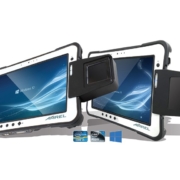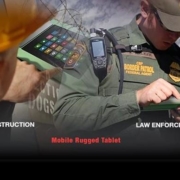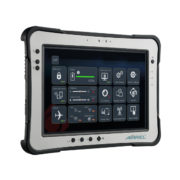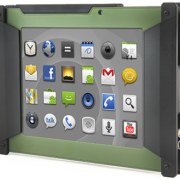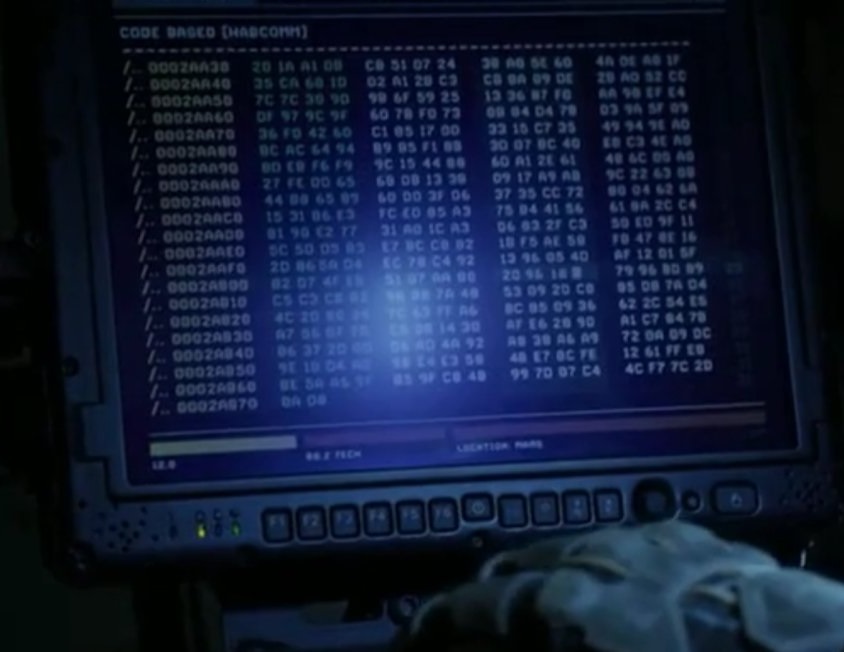LOS ANGELES (April 25, 2019) – The trusted provider of rugged biometric tablets, AMREL, announces that it will exhibit its newest integration of Suprema ID’s BM-Slim2 fingerprint sensor and optical scanner this month at Connect ID 2019, Suprema ID Booth #411. The world’s slimmest FAP20 optical sensor has been successfully integrated into AMREL’s 8-inch and 10.1-inch tablet models.
LOS ANGELES, Oct. 11, 2018 — An exceptionally versatile mobile device is now available from AMREL, the world’s premier rugged computer manufacturer. Infinitely customizable, this rugged, lightweight 8” Android tablet enables anyone to economically create highly specific detailed configurations.
“What a rip off! All you do is add is a few cents worth of rubber guards to your corners and call it rugged. The CPU of your rugged laptop is at least 2 years out of date. My regular old civilian laptop does a thousand things your laptop doesn’t. And rugged laptops are heavy, oversized monstrosities! How can you justify your ridiculous price?”
– Not an actual email from a not real customer.
Fortunately, the above fictitious email is not representative of our clients and partners. Most of the people with whom we deal understand the true worth of ruggedized computers. Every once in awhile we run into someone who is new to ruggedness and we have to sit down and explain the facts of life to them.
- “…all you do is add is a few cents worth of rubber guards to your corners.”
Actually, we do a lot more than that. AMREL’s computers are built rugged from the ground up. Most of the work that goes into them is not readily visible.
For example, AMREL laptops have a Fault Tolerant Isolation Design – an encapsulation process that protects individual components from water, dust, and other foreign matter. Analogous to a submarine, each chamber in the body of our laptops and on-board/fixed vehicle units is individually sealed. Protective chambers separate the following compartments: motherboard, I/O ports, removable hard drive, and swappable Application Modules.
Bear in mind that our rugged computers are not just built for getting knocked around. They have to meet exacting standards for operating in high/low pressure, rain, dust, humidity, salt fog, and extreme temperatures. This is one reason that “protective sleeves,” which promise to ruggedize your commercial computer are less than ideal.
- “The CPU of your rugged laptop is at least 2 years out of date. My regular old civilian laptop does a thousand things your laptop doesn’t.”
This is a criticism often leveled at technology fielded by the military, and that is not a coincidence. Many of the same factors that affect the military also affect us.
For example, the rugged computer market is much smaller than the commercial one, just as the military market is lesser than the consumer one. Not only does the lack of economy of scale mean we have to pay higher prices for specialized parts, but the lack of choice for vendors leads to uncontrollable delays. Delays lead to a longer development process, which hinders our ability to utilize the most recent technological advances.
Furthermore, ruggedized computers are used in critical applications for soldiers and police. We build computers as if someone’s life depended on it, because they often do. This leads to a quality control system that is far more strict and redundant than what commercial products are subjected to. To maintain such high standards, delays are inevitable.
So, our product development cycle, like all rugged computer manufacturers, is much longer. Greater and lengthier analyses and tests are required. Under these conditions, it’s almost impossible for any rugged computer to match the latest consumer products with their much shorter development cycles.
Still, AMREL is very conscious of the gap between the latest commercial products and typical ruggedized computers. The good news is that while it still is a problem, we have made real progress in bringing up-to-date technology to the rugged world.
One approach that we have taken is to design our rugged computers to be extremely flexible. Unlike commercial mobile platforms, ours are built to be quickly customized. Adding new technology is easy and convenient.
- “… how can you justify your ridiculous price?
As mention above rugged computers do not enjoy the same economy of scale as commercial ones.
However, this is a bit misleading, because rugged computers are a very good value for their price. This has been confirmed by every study that’s ever investigated this issue. The most well-known is by VDC Research who concluded that “Ruggedized Devices – both large and small form factor – achieve a distinct TCO advantage.”
TCO is Total Cost of Ownership. Not only does it include the initial price, but also platform support, integration, connectivity, lost work time, lost data, repair, and replacement cost. The later factors can be much greater than the initial price.
Another way of phrasing this is that rugged computers break down less often, need less repair, and last much longer than commercial grade ones. I don’t know about you, but whenever my commercial laptop gets over 4 years old, my repair man stars muttering ominous threats about his inability to get “ancient” parts, and how my motherboard won’t support the latest application or operating system. In contrast I know of one police department that has been using our laptops 7 days a week for 12 years. This sort of longevity is especially important to the military.
So complaining that rugged computers are more expensive than commercial ones is the same as comparing a 90-minute phone card with a 45-minute one, i.e. one is more expensive, but it lasts much longer.
- “And rugged laptops are heavy, oversized monstrosities!”
You haven’t been paying attention. AMREL has launched SlimLine, a new generation of extremely thin fully rugged laptops, tablets, and handhelds. They so radically change the conventional idea of durability, that one of our biggest problems is convincing our clients and partners that a laptop only an inch thick is actually fully rugged! We even have a rugged handheld that will run full Windows OS, but is so small that it will slide into a cargo pocket.
Still rugged mobile computers are not for everyone. You should NOT buy a rugged computer if:
- The data on your computer is not important, i.e. you don’t mind loosing it due to failure.
- Frequent downtimes and repairs are not a problem for you.
- You don’t care that you have to replace your handheld, laptop or tablet every few years.
- You operate your computer in an exceptionally stable, non-threatening environment.
If the above statements do not describe you, give one our experts a call at (800) 882-6735, or email us at cdinfo@amrel.com and learn more about the advantages of rugged computers.
AMREL announced the FBI’s certification of Flexpedient® AT80B Rugged Biometric Tablet. It is now on the exclusive FBI’s Certified Products Listing.
“The FBI has certified that the AT80B is in compliance with the CJIS Division’s Next Generation Identification System Image Quality Specifications (IQS): EBTS Mobile ID FAP 45 Appendix F Specifications,” explains Richard Lane, AMREL Vice President of Strategic Business Development. “It meets or exceeds the criteria for for Single & Dual Finger Flat & Rolled Print which means it can access the FBI’s Next Generation Identification (NGI) database.”
AMREL developed the AT80B in cooperation with Integrated Biometrics. Fingerprints are captured by the industry-leading Sherlock, an Integrated Biometrics module which utilizes a state-of-the-art Light Emitting Sensor. This sensor is fully rugged, uses little power, needs less maintenance than traditional methods, and captures FAP-45 quality images.
“Integrated Biometrics is proud that our LES technology is part of the Flexpedient® AT80B Rugged Biometric Tablet, a rugged device serving mobile identity needs in any environment,” said Mike Grimes, President of Integrated Biometrics.
This rugged tablet is designed to meet MIL-STD 810G and boasts an unusually durable IP67 rating. Built from the ground-up to be rugged, it is far tougher than a commercial tablet in a hardened case.
“The Flexpedient® AT80B Biometric Tablet is built on the AT80 platform,” explains Kalvin Chen, AMREL’s VP of Operations. “AT80’s unique channel design enables true off-the-shelf customization in a short period of time. The two-finger biometric sensor was added in less than a week.”
AMREL plans to leverage AT80B’s customization capabilities in order to serve the Law Enforcement community. For example, a smart card reader can be easily and quickly integrated into the AT80B platform. AMREL is exploring adding an iris camera.
When asked about this biometric device, Assistant Chief William ‘Bill’ Leist (Ret) California Highway Patrol replied, “The AT80B is designed to fit the needs of modern law enforcement. The enrollment capability for high quality fingerprint capture will save officers from making unnecessary trips to booking stations. Furthermore, its exceptional ruggedness will ensure it will not break down at critical times.”
Although special measures were taken to assist the Public Safety community, the AT80B is designed for use in a variety of situations. For example, this biometric tablet is being used by professional sports franchises to fast track VIP admissions at games. Another example is the Youth Detention Authority in South Africa, which has piloted the AT80B to verify visitors and track residents at facilities across the country.
Standard features include Android 4.3 (Jelly Bean), 8” 10-point multi-touch capacitive touchscreen display, front/back 5 MP cameras, 802.11 b/g/n, GPS, and Bluetooth®.
Learn more at: computers.amrel.com/at80b
AMREL has announced the launch of APEX PX5, a 10.1” fully rugged, sunlight readable tablet with one of the brightest and sharpest displays on the market.
“What sets the APEX PX5 apart is the crisp image quality,” explained Kalvin Chen, AMREL’s Vice President of Operations. “Its visual excellence is a result of more than the 1000 nits rating. It also has a bright backlight, anti-reflective coatings, WUXGA 1920 x 1200 resolution, and directly bonded LCD layers. Very simply, the APEX PX5 has one of the best displays on any rugged tablet in the world.”
Built into the APEX PX5 is AMREL’s 30 years of expertise of supplying fully rugged computers to the frontline warfighters as well as Public Safety officers. In addition to its enviable IP65 rating, it complies with MIL-STD 810G, the military’s premier ruggedness standard.
“With scratch-resistant Corning Gorilla Glass 3, tough magnesium chassis, and a durable ABS plastic cover, you can have complete confidence in the APEX PX5 Tablet no matter where you take it,” declares Mr. Chen. “In spite of all this ruggedness, the lightweight APEX PX5 is less than an inch thick.”
The APEX PX5 is built to meet modern demands. Boasting a speedy 4th generation Intel® Haswell Core ™ i5 processor, the APEX PX5 Tablet is ideal for graphic and other data-intensive applications. Its capacitive multi-touch supports glove touch, and a digitizer option. Other options include snap-on modules for magnetic stripe reader, smart card (CAC), NFC, as well as 2D barcode. To complete the tablet’s offering, it has a vehicle dock, desktop dock, VESA mount bracket, 2-bay battery charger, and dual capacity battery pack for extended use. The APEX PX5 supports Public Safety, industrial, field service, and commercial applications.
“We’re proud of the flexibility of the operating systems,” states Mr. Chen. “You can choose to use either full Windows 7, or Windows Professional or Embedded 8.1. You even have an option to install Windows 10 Internet of Things Enterprise.”
Learn more at computers.amrel.com/apex-px5
I have encountered an interesting prejudice. Some people have confidently informed me that the smaller the form factor, the more reliable it is. Laptops are more reliable than desktops, but less reliable than tablets, which aren’t as rugged as handhelds.
To be clear, whatever rugged platform AMREL sells you – tablet, laptop, or handheld – it has been built for the utmost reliability. We build our computing solutions as if lives depend on them, because a lot of the times lives do depend on them.
If you have never heard of the “smaller is more dependable” myth, don’t worry about it; most of the experts that I talked to never heard of it either. In fact, for reasons, which will be explained, it doesn’t make sense on multiple levels.
Still, I wondered why some people might think their smaller platforms are more dependable. Here are few theories.
The problem is not the hardware, but the operating system (OS). Most desktops still use Windows, while many smaller form factors do not. Some point to Windows as the culprit behind the “bigger is more unreliable” myth. Windows has a number of issues which could contribute to more frequent breakdowns.
For one thing, the Windows OS on your desktop has a lot of updates, whereas the Android OS on your smartphone may be frozen. Frequent updates create more points of failure and more “bloated” software. Furthermore, Windows seeks updates during the boot process, which can overload the CPU, leading to a significantly slower starting time.
Legacy issues are another cause of “bloated” software. Your brand new Windows OS has to accommodate programs that were written when floppy discs were still considered an exciting new innovation. This leads to complications, more resources being used, and just more problems. Also, developers for the newer Android OS can learn from the mistakes that Windows has made previously.
Some claim that Windows is more susceptible to malware and viruses than the OS typically used on smartphones. This makes sense considering how much older and widespread Windows OS are.
In addition to the Windows OS, some point the finger at poorly written applications. Apple is notoriously strict about the apps than can run on its equipment. Windows less so.
Nope, hardware is the problem. Supposedly, hardware used in laptops and desktops are much more varied than those found in tablets and smartphones. This is more challenging for their OS, and a more diverse supply chain contributes to quality issues. I am not sure this is true, but some folks believe it.
More flexibility means less rigidity, which means less reliability. You have a lot more options on your desktop than your smartphone. A simpler, locked-in, frozen device has less ways of fouling up. It is more likely that your machine gun will jam than your sword will break.
The simplicity of the smaller form factors means they’re easier to upgrade. All computer companies constantly improve their platforms. However, smartphone manufacturers have an easier time of fixing problems, because of the more limited nature of their solutions. Again, I am not sure I totally buy this explanation, but it is an argument that I have heard.
Actually, smartphones are not more reliable than desktops. We throw away broken smartphones. We repair desktops. We mentally compartmentalize the two tasks differently, so we think never think about debugging smartphones, whereas we remember the frequent annoying calls to tech support for our desktops. Think of how often you buy a smartphone as compared to how often you buy a laptop or desktop.
The “smaller is more reliable” myth is really, stupid and reflects a fundamental misunderstanding about technology. By far and away, this was the sentiment that I heard expressed the most by AMREL’s engineers.
“Compared to a smartphone, a desktop is a large truck,” explained Magnus Pyk, AMREL’s Director of Engineering. “It has more power, more torque, and just more room for more stuff. You can put an entire recording studio on a desktop, far more than what a tablet or smartphone is capable of. Smaller form factors are lowered powered, simpler systems. This is worse than comparing apples to oranges.”
In other words, you can’t compare the different platforms, because they are not comparable. They are built for entirely different range of capabilities. A compact car might get better gas mileage than a tank, but if I had to go into battle, I know which vehicle I would want.
Whatever form factor you do decide on, you may want to check out AMREL’s complete list of offerings. No matter what size platform you choose, we have one that you will absolutely, positively be able to depend on.
Sometimes it takes an outsider to state the obvious. AMREL built the Flexpedient® AT80 Android Tablet to be an infinitely configurable computer platform that could be customized quickly and simply. Still we were surprised when Conrad Blickenstorfer, Editor in Chief of Rugged PC review began his analysis of the AT80 tablet with the headline, “Your company, too, can be a virtual rugged tablet manufacturer with this eminently sensible, customizable, personalizable 8-inch Android device.”
While AMREL saw the AT80 as a practical way to speed product development through customized off-the-shelf platforms, we hadn’t really thought of it as an opportunity for white labeling rugged tablets. Now that Conrad has said it, it seems obvious. As he writes in his review:
“Does that mean it’s like going on Dell’s or Apple’s online store and click all the options you want? Yes, but it goes beyond that. Customers — and we’re really talking enterprise and government customers here — aren’t limited to just picking a few options; they can specify very detailed configuration requests, whatever they may be, and then select from no fewer than ten different colors and add their own logo and brand to the tablet. AT80 customers, in other words, become virtual manufacturers….
“…All of this makes this AMREL tablet far more than just a tablet with a bunch of options. For customers, it’s more like specifying their very own tablet, either for their own use, for resale, or for packaging with specialized software.”
Conrad was impressed with the AT80’s toughness (“We put the tablet through its paces in ice and snow, and it never missed a beat”), as well as its light weight and thinness (less than an inch). He also praised the quality of the back and front cameras, which is impressive to those who follow Conrad’s work; one of his pet peeves is the poor quality of cameras on rugged computers.
Conrad wrote:
“When the AMREL AT80 first came into our lab, we didn’t quite know what to make of it. It was just so different from AMREL’s (or anyone else’s) rugged tablets. But the more we examined it and used it, the more we liked it. If the AT80 were a vehicle, it’d be a Jeep. Basic, tough, sensible, indestructible. But whereas Jeeps have always been bare-bones and not terribly refined, the AT80 feels very high-tech despite its basic construction, and it operates as smoothly and responsively as any consumer smartphone or tablet.”
Download AT80’s datasheet from AT80.amrel.com and ask about our current promotion.
The AT80 is just the latest platform that AMREL has developed for quick and easy customization. One of AMREL’s mottos is “We don’t just sell rugged computers. We sell rugged customized solutions.” See a sample of our customized solutions at computers.amrel.com/custom-solutions. To speak to one of AMREL’s Customized Solution Engineers, call 800-882-6735 or email cdinfo@amrel.com.
When offices first went digital, a large number of businesses failed to successfully integrate computers. One story that I heard more than once was “We bought computers six months ago. Now they sit on the shelf in a closet where they are a very expensive way of gathering dust.”
Something like this is currently happening with mobile solutions. An estimated 100 million workers use mobile devices for business purposes. However, a surprisingly large number of mobile business solutions have failed. Here, at AMREL, we hear a lot about them, because we have reputation for technical support, i.e. we get many calls about problems affecting other companies solutions, because the end users are so frustrated with the original supplier that they try contacting us.
Before you buy a mobile communication solution, here are a few of things to look for:
1) Lack of user buy in. This is probably the number one cause of failure, and many of the examples given here are really just a variation of this problem. The end-user (field personnel, maintenance worker, salesman, warfighter, warehouse worker, etc.) simply doesn’t want to use the shiny, new mobile device. Pen and pencil worked fine all this time. Why should he invest energy in making a change?
Before one deploys a communication solution, survey the end user. What are their needs? Their challenges? After the system is rolled out, survey them again and again. Are they having problems with the new solution? What changes do they recommend? Be prepared for a lot of tweaking even after the system is deployed. Remember: You don’t get decide when you are done with the solution deployment. It may never end.
2) Overlooking back-end and software functionality. This was much more of a problem in the past than it is now. The older generation viewed software as an afterthought, while hardware was the “real” heart of the solution.
Still this problem shows up even today. Is the application user-friendly? Does it enable the end-user to perform their most important tasks? Has the app been optimized for mobile devices? Is the back-end scalable so you can adjust it for future needs? Is the back-end off the shelf or specifically made for your enterprise? If it is unique, does that mean you’re locked into support by one vendor? These are questions that businesses have learned to ask the hard way.
3) End-to-end solutions. This is an example of a “back-end” problem mentioned above. End-to-end solutions can be great, but let me tell you an example in which they weren’t.
A big city police department needed a new in-vehicle solution. They replaced their mobile computers with a cheaper brand, which only worked with the manufacturer’s proprietary software. The department thought they were getting a great deal, because the initial price was lower than anything else on the market.
The software was a disaster. Officers didn’t get emergency messages quickly or sometimes not at all. The entire system (in-vehicle computers and software) was replaced in a year.
Several years ago, I attended a seminar in which large Public Safety departments described how they were going to meet FirstNet requirements. Several participants railed against end-to-end solutions. I don’t agree; some end-to-end systems work well. But I can’t say that I was surprised by the vehemence that was expressed.
4) End user literally can’t see the information on the screen. The screen is washed out by the sun or is too small to accurately display the information needed for the task. Seems obvious, but businesses have been known to overlook this.
5) No keyboard. Tablets work fine for checklists, but what about the comments section, which can be a critical part of a worker’s responsibilities? One company failed to get productivity gains for field personnel, because all waited to get back to the office before inputting data. Since they were going to sit down at their desktops anyway, why split the work of data entry into two tasks? Of course, you can always buy a tablet with a QWERTY keyboard, such as AMREL’s ROCKY DT10.
6) Politics and brand loyalty. Buy an iPad if it fits your enterprise’s needs. Don’t buy it to look cool. The Los Angeles Unified School District paid a very expensive price for this lesson.
7) Access to databases. Another version of the “back-end” problem. Some workers will not use their mobile devices if they can’t access databases, such as product catalog, CRM, and order entry systems. Lack of access prevented them from completing their tasks, so just like the field workers above, they waited until getting back to the office to input data. Don’t assume you know what info they need. Ask them.
8) Workers are scared to use mobile devices, because they are expensive. Some companies are especially punitive toward workers who damage their mobile devices, so they simply leave them in the box and never use them. Give your staff peace of mind, save money in the long run, and buy rugged computers.
9) Can’t physically carry the device. Supervisors assumed that warehouse workers would always have a free hand to use a mobile device. Turned out they were wrong. When strapped to belts, the devices always got in the way, and workers needed two hands for most tasks. Hate to sound repetitive, but, again, ask the end user.
10) Bring Your Own Device (BYOD). There are advantages and disadvantages to this popular policy. Read about it here.
The above is not meant to be complete, but rather a collection of anecdotes that we have heard over the years. Do you have your own mobile story? Send it to editor@amrel.com.
AMREL announces the release of the ROCKY DT10, an upgraded version of its sunlight readable, fully rugged tablet with a built-in keyboard.
“There are several significant upgrades,” explains Javier Camarillo, AMREL’s Senior Application Engineer. “Many will notice the bright 700 nits rating. Another visual upgrade is the display’s optical bonding, which is a special technique that reduces the refraction and reflection that occurs between the different layers of the display. This enhances sunlight readability, which is especially important since the DT tablet series is often used for outdoor applications.”
An additional major upgrade is its Intel® i7 processor. This gives ROCKY DT10 the power to process modern data-heavy applications, including ones that were once reserved solely for desktop use.
With its built-in QWERTY keyboard, the ROCKY DT10 is perfect for field and logistical applications. It gives you the mobility to go anywhere, and the ability to type reports once you’re there.
“We do a lot of customization,” stated Mr. Camarillo. “So we listen to what our customers want. They told us they liked the portability of a tablet, but needed the functionality of a keyboard. Of course it had to be rugged, in order to operate in challenging environments.”
AMREL has been fielding rugged computers for over 30 years. As with any platform, our computers can be purchased as COTS or modified COTS to meet the specific requirements of your application.
The ROCKY DT10 may be used as a stand-alone tablet or for in-vehicle applications. Its hard drive can be easily removed as the situation in the field requires.
Specifications include:
- Windows 7/Windows 8.1 / Windows 10
- 9.0” XGA LCD, 1280 x 768, LED 700 nits
- Resistive single-touch panel, Optical Bonding, Anti-Glare & Anti-Reflective
- Intel Sandy Bridge i7-2610UE
- 8 GB, DDR-III 1333 MHz
- Intel® HD Graphics 3000
- Removable 500GB 2.5” SATA II HDD (Upgradeable)
- Solid state hard drives (SSHD) available
- Options: Wireless LAN, WAN, PAN, GPS, Built-in Bluetooth
- MIL-STD 810G, MIL-STD 461F Compliant
- IP-54 (Dust-protected; splashing water)
The ROCKY DT10 is ideal for applications that demand portability, capability and ruggedness, including Defense, Oil & Gas, Mining, Inventory control, Warehouse operations, Meter reading, Agriculture, Port Container Control, Homeland Security, Law Enforcement, and Geological /Scientific Field Research.
Learn more about the ROCKY DT10 at computers.amrel.com/dt10/
If you have seen The Martian you may have noticed the appearance of our ROCKY DK10 rugged tablet. Using hexadecimal language, it’s Matt Damon’s only communication with Earth.
Although not rated for extraterrestrial use, the choice of the DK10 is not surprising. The Hurt Locker, The Losers, Zero Dark Thirty, and other movies have all featured AMREL solutions.
Movie makers know what warfighters and Law Enforcement professionals know; when you need a product that will reliably operate in a challenging environment, choose AMREL.
American Reliance, Inc.
789 N Fair Oaks Ave,
Pasadena, CA 91103
Office Hours
Monday-Friday:
8:00 am – 5:00 pm PST
Saturday: Closed
Sunday: Closed
Main: +1 (626) 482-1862
Fax: +1 (626) 226-5716
Email: AskUs@amrel.com
Blog Posts
Mobile Biometric Solutions
Mobile Biometric Smartphones & Tablets
BioFlex S® Commercial Smartphones
BioSense AT80B | 8″ Android Biometric Tablet
BioSense PA5 | 10.1″ (Gen 2) Android Biometric Tablet
BioSense PA5 | 10.1″ Android Biometric Tablet
BIOPTIX PM3B | 7″ Windows Biometric Tablet
BIOPTIX PM5B | 10.1″ Windows Biometric Atom Tablet

